The Forming Control Method of Multi-Track Laser Cladding on Curved Surface
Abstract
1. Introduction
2. Materials and Methods
3. Results and Discussion
3.1. Significance Test and Analysis of Variance
3.2. Analysis of Flatness Ratio
3.3. Analysis of Pore Area
3.4. Processing Parameters Optimization and Experimental Validation
4. Conclusions
- The flatness ratio of the cladding layer was significantly influenced by the overlap ratio. Under the relatively low laser power in the studied range, the flatness ratio slightly decreased with the reducing scanning speed. Under relatively high laser power in the studied range, the flatness ratio showed a significant increase upon reducing the scanning speed. Decreasing the laser power and overlap ratio simultaneously caused the flatness ratio to increase. Decreasing both the scanning speed and overlap ratio also lead to the flatness ratio increasing.
- The scanning speed, gas flow, and overlap ratio had an influence on the pore area. With the increase of laser power and overlap ratio, the pore area was showing a trend of decreasing at first and then increasing afterwards. Increasing the gas flow and overlap ratio led the pore area to increase initially, which was followed by a decrease.
- Processing parameters optimization was conducted comprehensively by considering maximizing the flatness ratio and minimizing the pore area in the clad. Through experimental validation, a different extent of improvement was found for the flatness ratio and pore area compared with the original CCD design. In addition, given the optimized processing parameters setup, the flatness ratio and pore area prediction were computed by the established mathematical models. Compared with the validation experiment values of the flatness ratio and pore area, predicting the adequacy of the models was verified and showed the application potential of the forming control of clad properties in curved surface laser cladding.
Author Contributions
Funding
Acknowledgments
Conflicts of Interest
References
- Devojno, O.; Feldshtein, E.; Kardapolava, M.; Lutsko, N. On the formation features, microstructure and microhardness of single laser tracks formed by laser cladding of a NiCrBSi self-fluxing alloy. Opt. Lasers Eng. 2018, 106, 32–38. [Google Scholar] [CrossRef]
- Jiang, Y.; Li, J.; Juan, Y.; Lu, Z.; Jia, W. Evolution in microstructure and corrosion behavior of AlCoCrxFeNi high-entropy alloy coatings fabricated by laser cladding. J. Alloys Compd. 2019, 775, 1–14. [Google Scholar] [CrossRef]
- Sun, S.D.; Barr, C.; Brandt, M. In situ control of tempered martensite during laser cladding repair of aero-grade 300M steel using AISI 420 stainless steel powder. J. Laser Appl. 2018, 30, 032502. [Google Scholar]
- Liu, H.; Qin, X.; Huang, S.; Hu, Z.; Ni, M. Geometry modeling of single track cladding deposited by high power diode laser with rectangular beam spot. Opt. Lasers Eng. 2018, 100, 38–46. [Google Scholar] [CrossRef]
- Liu, J.; Yu, H.; Chen, C.; Weng, F.; Dai, J. Research and development status of laser cladding on magnesium alloys: A review. Opt. Lasers Eng. 2017, 93, 195–210. [Google Scholar] [CrossRef]
- Zeng, C.; Tian, W.; Liao, W.H.; Hua, L. Microstructure and porosity evaluation in laser-cladding deposited Ni-based coatings. Surf. Coat. Technol. 2016, 294, 122–130. [Google Scholar] [CrossRef]
- Nabhani, M.; Razavi, R.S.; Barekat, M. An empirical-statistical model for laser cladding of Ti-6Al-4V powder on Ti-6Al-4V substrate. Opt. Laser Technol. 2018, 100, 265–271. [Google Scholar] [CrossRef]
- Li, Y.; Dong, S.; Yan, S.; Liu, X.; He, P.; Xu, B. Microstructure evolution during laser cladding Fe-Cr alloy coatings on ductile cast iron. Opt. Laser Technol. 2018, 108, 255–264. [Google Scholar] [CrossRef]
- Erfanmanesh, M.; Abdollah-Pour, H.; Mohammadian-Semnani, H.; Shoja-Razavi, R. An empirical-statistical model for laser cladding of WC-12Co powder on AISI 321 stainless steel. Opt. Laser Technol. 2017, 97, 180–186. [Google Scholar] [CrossRef]
- Shi, J.; Zhu, P.; Fu, G.; Shi, S. Geometry characteristics modeling and process optimization in coaxial laser inside wire cladding. Opt. Laser Technol. 2018, 101, 341–348. [Google Scholar] [CrossRef]
- Ansari, M.; Razavi, R.S.; Barekat, M. An empirical-statistical model for coaxial laser cladding of NiCrAlY powder on Inconel 738 superalloy. Opt. Laser Technol. 2016, 86, 136–144. [Google Scholar] [CrossRef]
- Farahmand, P.; Kovacevic, R. Parametric study and multi-criteria optimization in laser cladding by a high power direct diode laser. Lasers Manuf. Mater. Process. 2014, 1, 1–20. [Google Scholar] [CrossRef]
- Saqib, S.; Urbanic, R.; Aggarwal, K. Analysis of laser cladding bead morphology for developing additive manufacturing travel paths. Procedia CIRP 2014, 17, 824–829. [Google Scholar] [CrossRef]
- Calleja, A.; Tabernero, I.; Fernández, A.; Celaya, A.; Lamikiz, A.; De Lacalle, L.L. Improvement of strategies and parameters for multi-axis laser cladding operations. Opt. Lasers Eng. 2014, 56, 113–120. [Google Scholar] [CrossRef]
- Tabernero, I.; Calleja, A.; Lamikiz, A.; De Lacalle, L.L. Optimal parameters for 5-axis laser cladding. Procedia Eng. 2013, 63, 45–52. [Google Scholar] [CrossRef]
- Lian, G.; Yao, M.; Zhang, Y.; Chen, C. Analysis and prediction on geometric characteristics of multi-track overlapping laser cladding. Int. J. Adv. Manuf. Technol. 2018, 97, 2397–2407. [Google Scholar] [CrossRef]
- El Cheikh, H.; Courant, B.; Branchu, S.; Hascoet, J.Y.; Guillén, R. Analysis and prediction of single laser tracks geometrical characteristics in coaxial laser cladding process. Opt. Lasers Eng. 2012, 50, 413–422. [Google Scholar] [CrossRef]
- Liu, S.; Kovacevic, R. Statistical analysis and optimization of processing parameters in high-power direct diode laser cladding. Int. J. Adv. Manuf. Technol. 2014, 74, 867–878. [Google Scholar] [CrossRef]
- Chen, C.; Lian, G.; Jiang, J.; Wang, Q. Simplification and experimental investigation of geometrical surface smoothness model for multi-track laser cladding processes. J. Manuf. Process. 2018, 36, 621–628. [Google Scholar] [CrossRef]
- Wen, P.; Feng, Z.; Zheng, S. Formation quality optimization of laser hot wire cladding for repairing martensite precipitation hardening stainless steel. Opt. Laser Technol. 2015, 65, 180–188. [Google Scholar] [CrossRef]
- Lian, G.; Zhang, H.; Zhang, Y.; Tanaka, M.L.; Chen, C.; Jiang, J. Optimizing processing parameters for multi-track laser cladding utilizing multi-response Grey relational analysis. Coatings 2019, 9, 356. [Google Scholar] [CrossRef]
- Lian, G.; Zhang, H.; Zhang, Y.; Chen, C.; Huang, X.; Jiang, J. Control and prediction of forming quality in curved surface multi-track laser cladding with curve paths. Int. J. Adv. Manuf. Technol. 2020, 106, 3669–3682. [Google Scholar] [CrossRef]
- Alam, M.K.; Urbanic, R.J.; Nazemi, N.; Edrisy, A. Predictive modeling and the effect of process parameters on the hardness and bead characteristics for laser-cladded stainless steel. Int. J. Adv. Manuf. Technol. 2018, 94, 397–413. [Google Scholar] [CrossRef]
- Zhou, C.; Zhao, S.; Wang, Y.; Liu, F.; Gao, W.; Lin, X. Mitigation of pores generation at overlapping zone during laser cladding. J. Mater. Process. Technol. 2015, 216, 369–374. [Google Scholar] [CrossRef]
- Zhou, S.; Dai, X.; Zheng, H. Microstructure and wear resistance of Fe-based WC coating by multi-track overlapping laser induction hybrid rapid cladding. Opt. Laser Technol. 2012, 44, 190–197. [Google Scholar] [CrossRef]


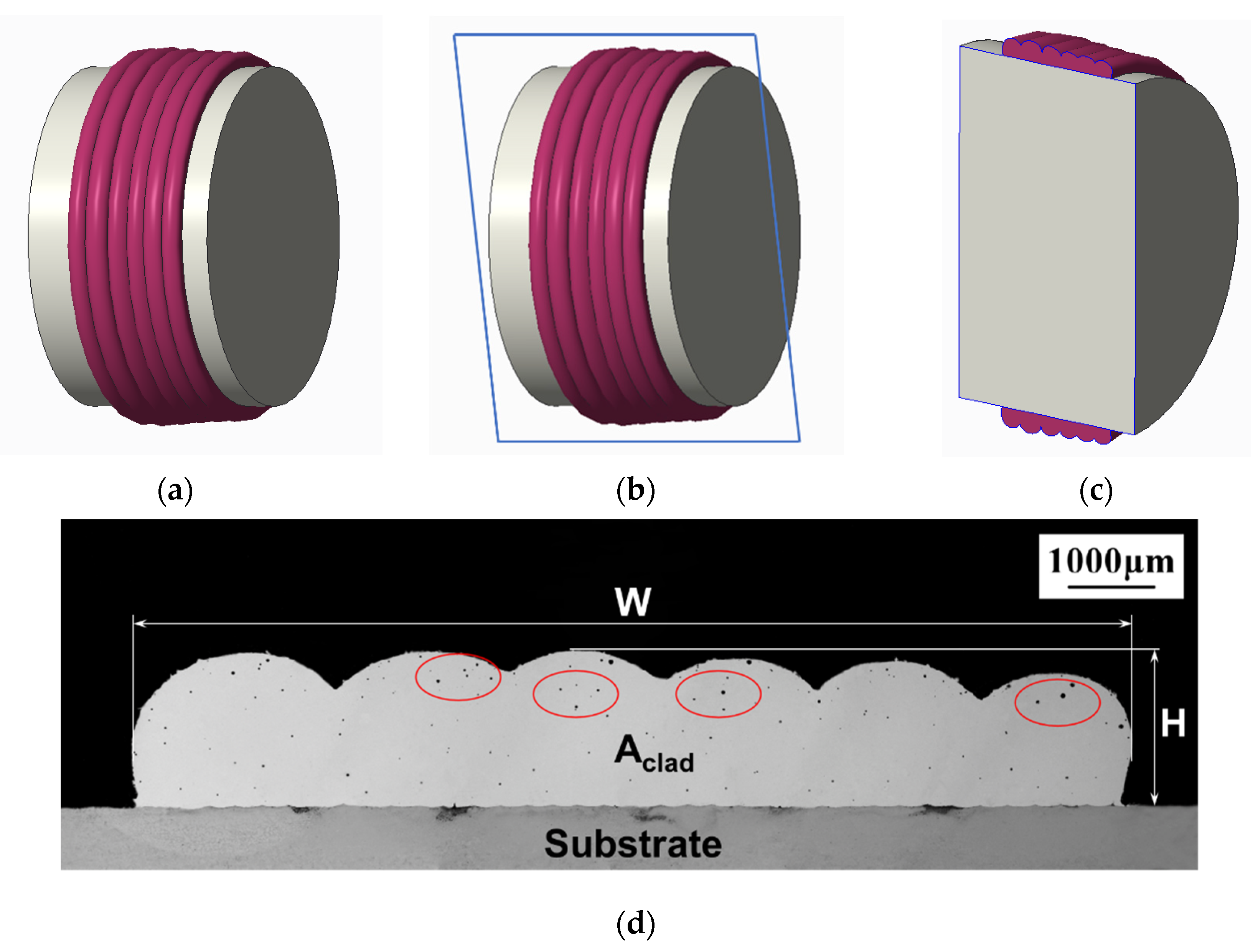

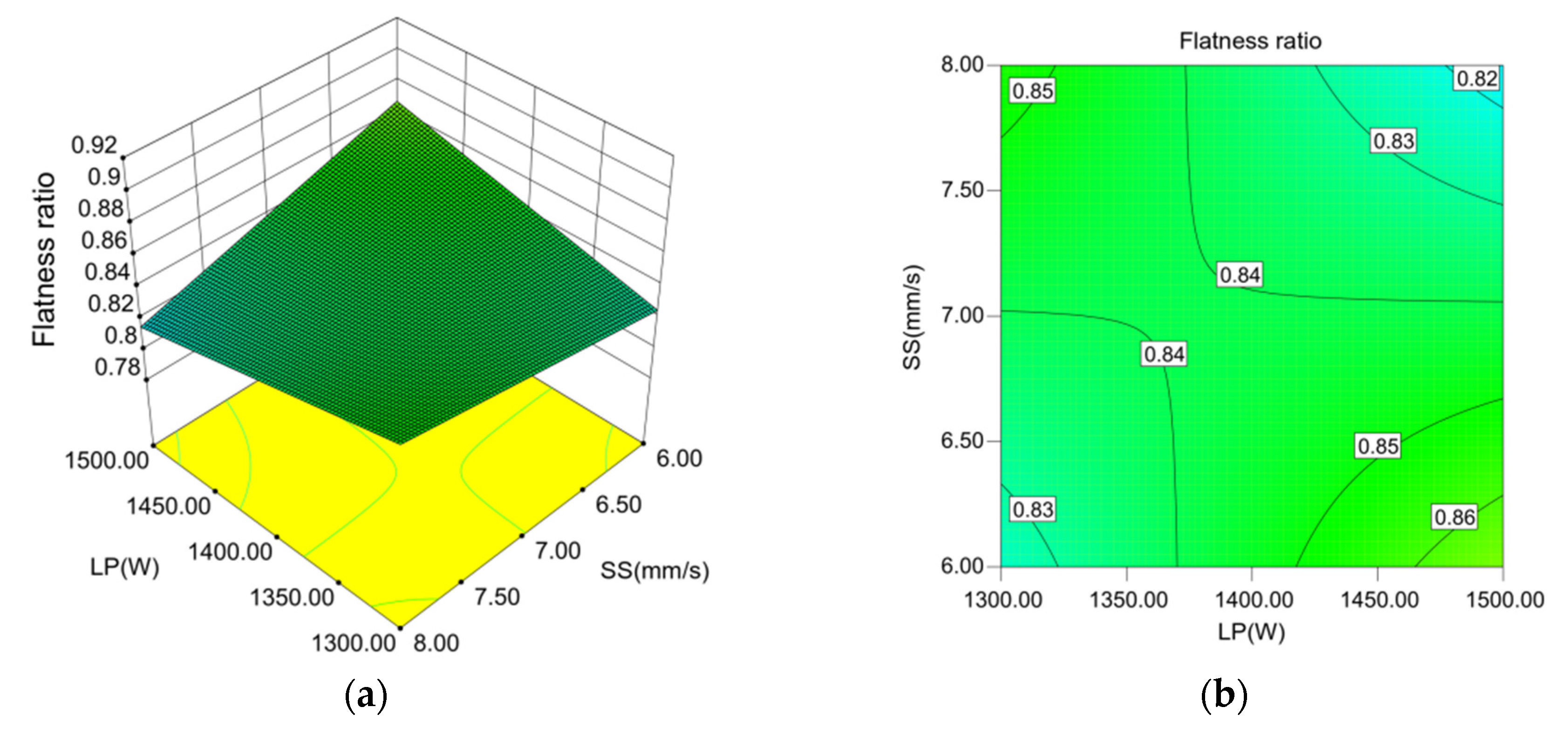

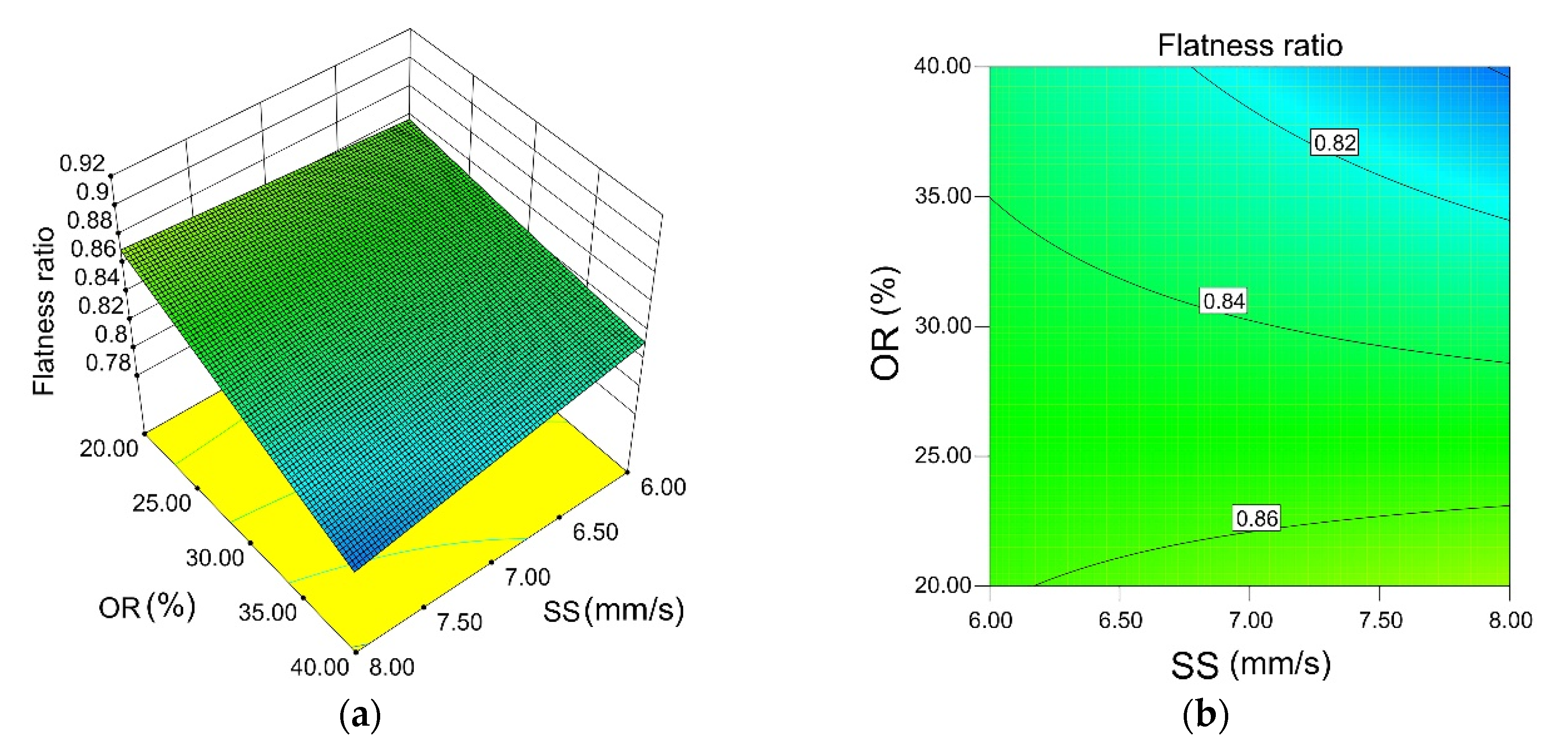
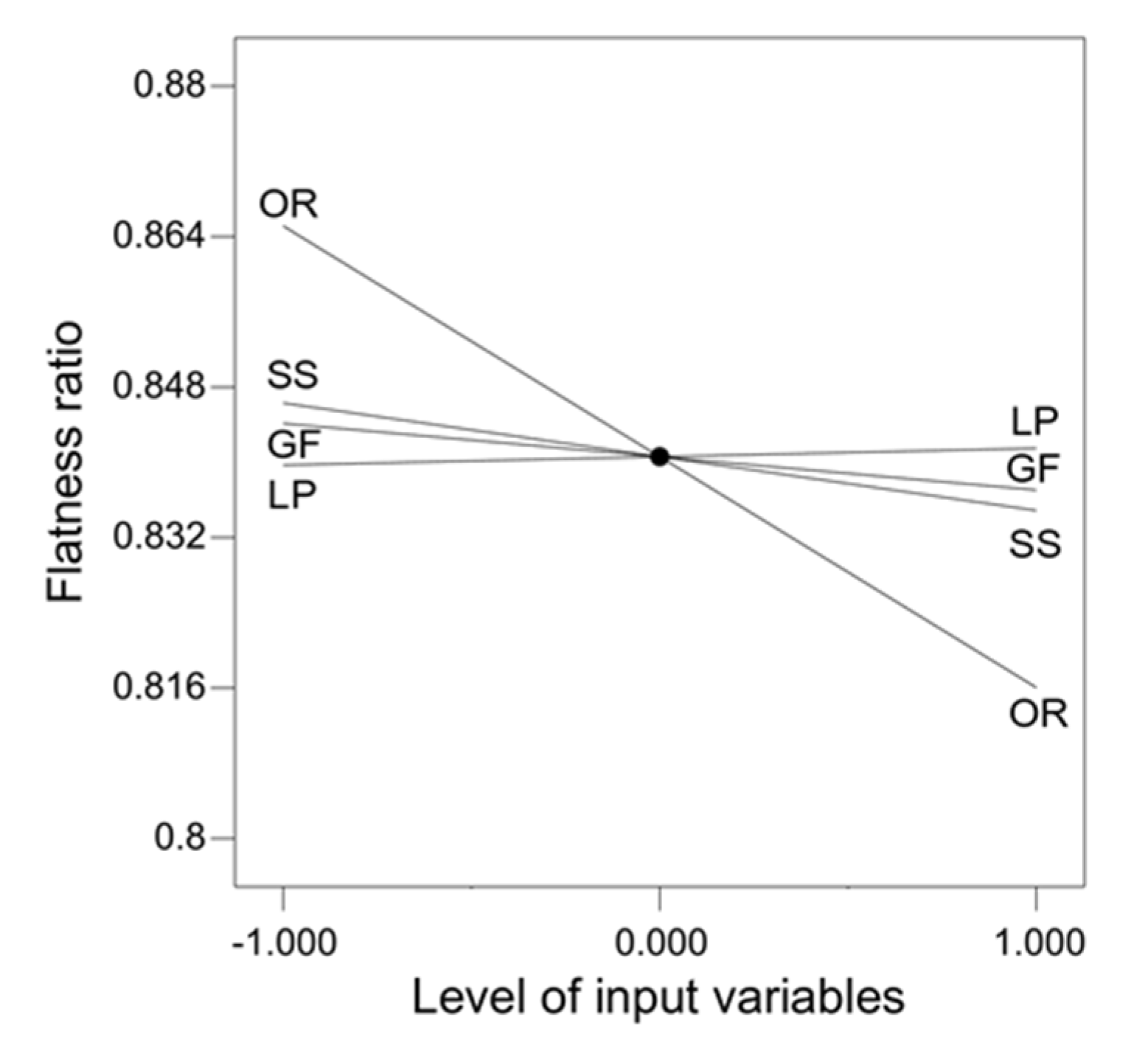
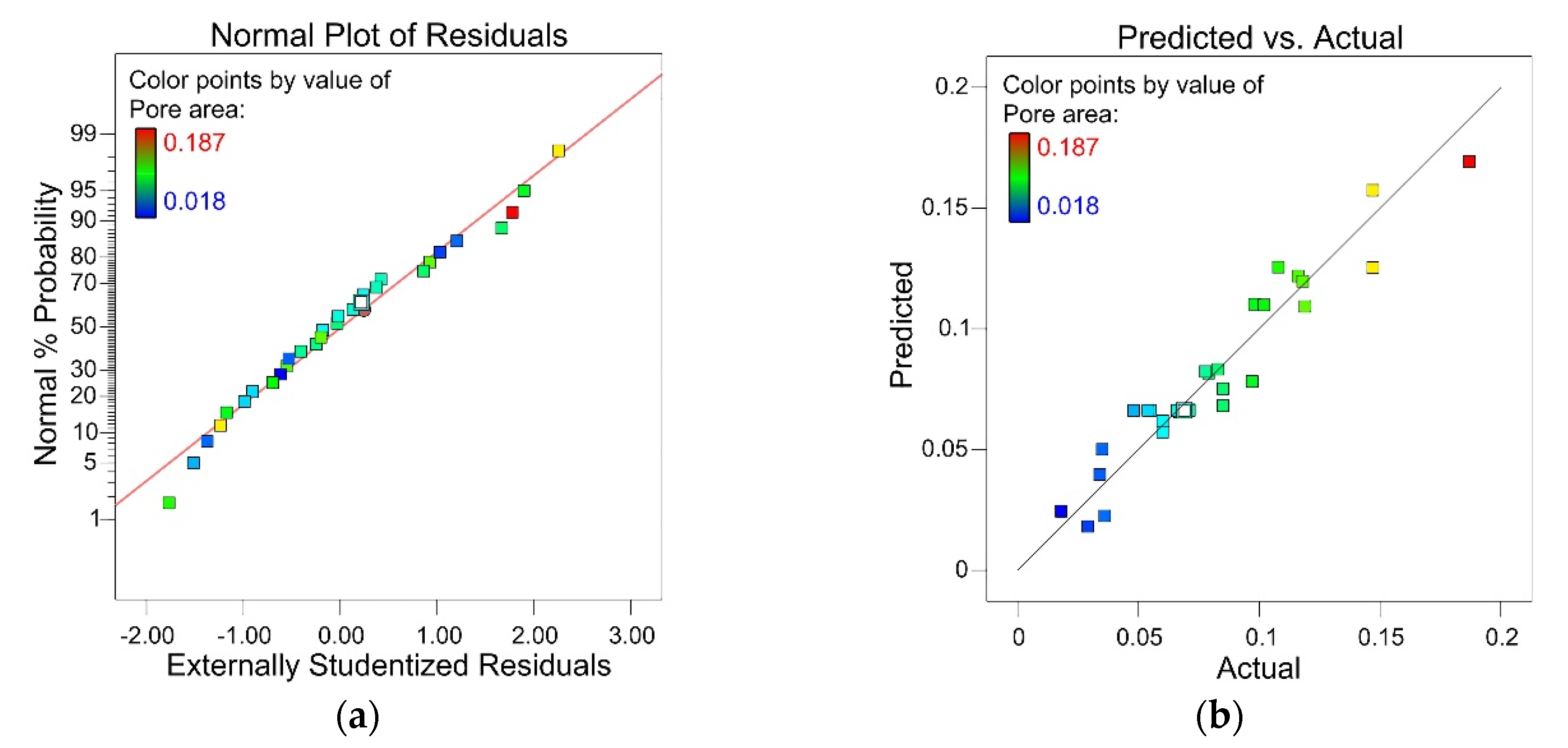
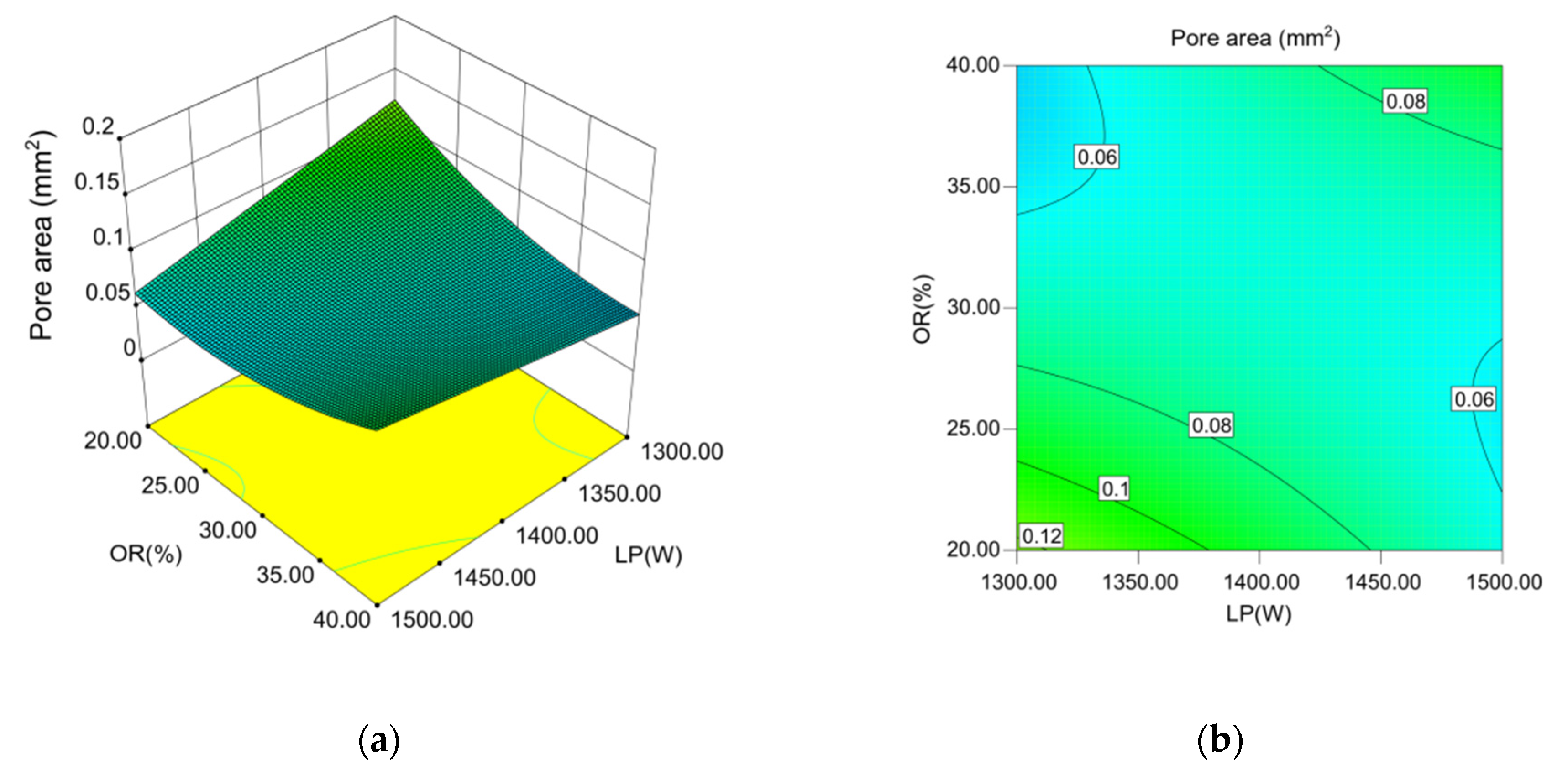

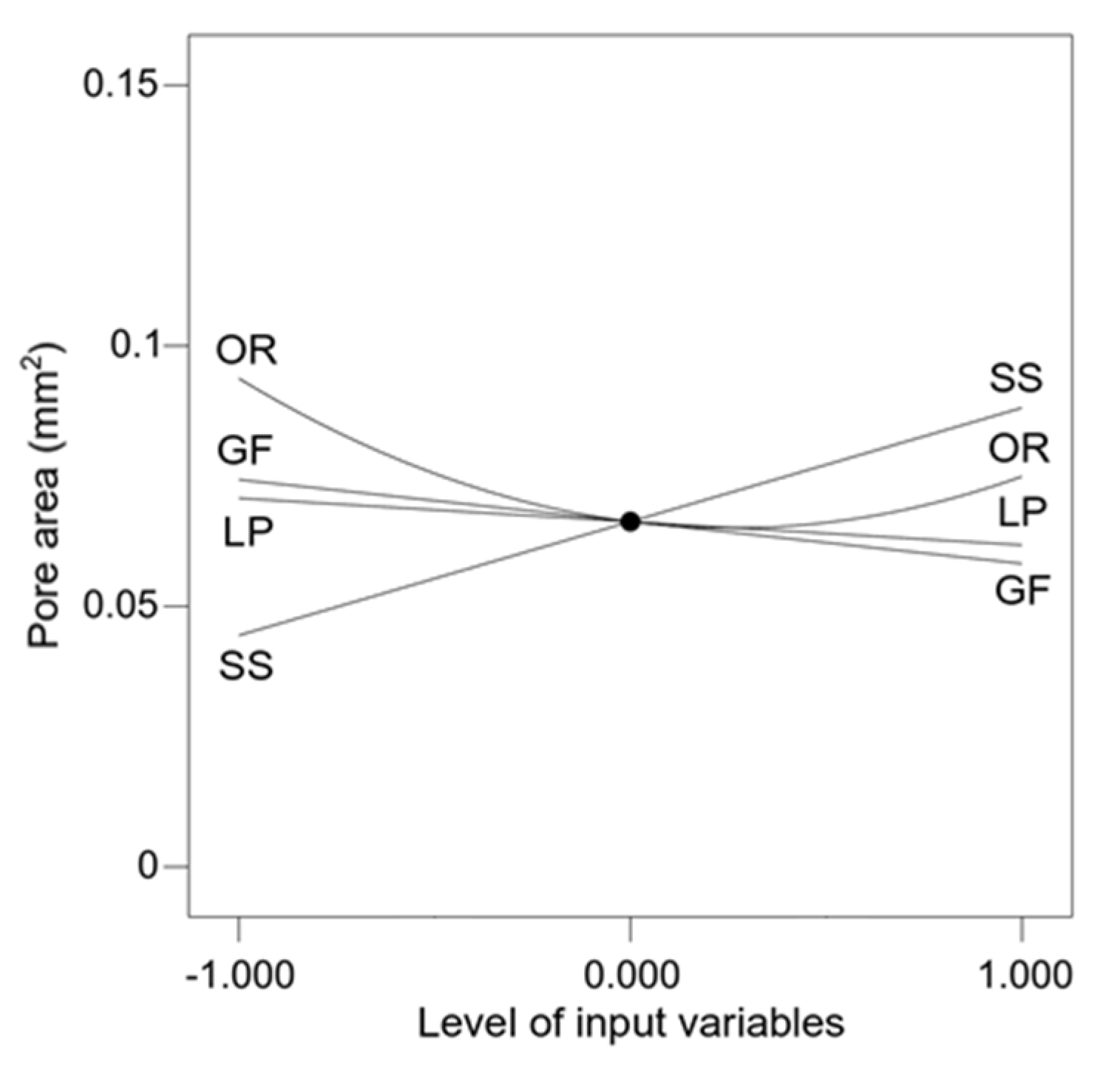
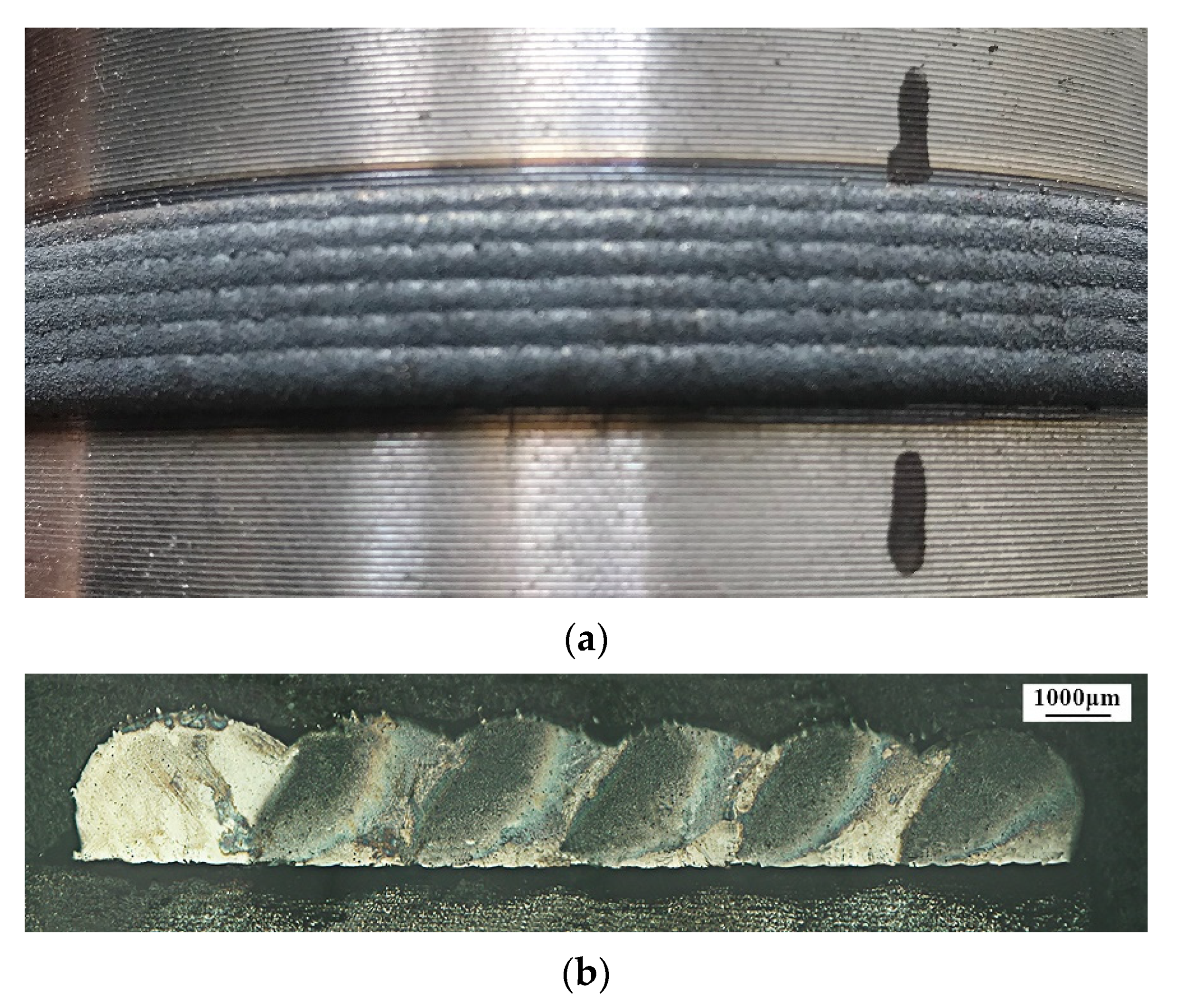
| C | Si | Mn | Cr | Mo | V | W | Fe |
|---|---|---|---|---|---|---|---|
| 0.8–0.9 | 0.15–0.4 | 0.2–0.45 | 3.8–4.4 | 4.5–5.5 | 1.75–2.2 | 5.5–6.75 | Rest |
| Input Variables | Notation | Unit | Levels | ||||
|---|---|---|---|---|---|---|---|
| –2 | –1 | 0 | 1 | 2 | |||
| Laser Power | LP | W | 1200 | 1300 | 1400 | 1500 | 1600 |
| Scanning Speed | SS | mm/s | 5 | 6 | 7 | 8 | 9 |
| Gas Flow | GF | L/h | 800 | 900 | 1000 | 1100 | 1200 |
| Overlap Ratio | OR | % | 10 | 20 | 30 | 40 | 50 |
| Run | LP (W) | SS (mm/s) | GF (L/h) | OR (%) | Flatness Ratio | Pore Area (mm2) |
|---|---|---|---|---|---|---|
| 1 | 1400 | 7.00 | 1000.00 | 50.00 | 0.783946 | 0.118 |
| 2 | 1300 | 8.00 | 1100.00 | 20.00 | 0.908787 | 0.116 |
| 3 | 1500 | 6.00 | 1100.00 | 20.00 | 0.863892 | 0.029 |
| 4 | 1400 | 7.00 | 1000.00 | 30.00 | 0.843260 | 0.054 |
| 5 | 1500 | 6.00 | 1100.00 | 40.00 | 0.865208 | 0.079 |
| 6 | 1400 | 5.00 | 1000.00 | 30.00 | 0.852268 | 0.036 |
| 7 | 1400 | 7.00 | 1000.00 | 30.00 | 0.849350 | 0.071 |
| 8 | 1300 | 8.00 | 1100.00 | 40.00 | 0.798156 | 0.083 |
| 9 | 1500 | 8.00 | 900.00 | 20.00 | 0.838793 | 0.119 |
| 10 | 1400 | 9.00 | 1000.00 | 30.00 | 0.820694 | 0.102 |
| 11 | 1300 | 6.00 | 900.00 | 40.00 | 0.803049 | 0.018 |
| 12 | 1400 | 7.00 | 1000.00 | 30.00 | 0.844027 | 0.048 |
| 13 | 1500 | 6.00 | 900.00 | 20.00 | 0.850577 | 0.067 |
| 14 | 1300 | 8.00 | 900.00 | 40.00 | 0.808828 | 0.085 |
| 15 | 1400 | 7.00 | 1000.00 | 30.00 | 0.841514 | 0.055 |
| 16 | 1400 | 7.00 | 1000.00 | 30.00 | 0.851179 | 0.066 |
| 17 | 1500 | 8.00 | 1100.00 | 40.00 | 0.795317 | 0.147 |
| 18 | 1200 | 7.00 | 1000.00 | 30.00 | 0.822637 | 0.085 |
| 19 | 1300 | 8.00 | 900.00 | 20.00 | 0.918344 | 0.187 |
| 20 | 1500 | 6.00 | 900.00 | 40.00 | 0.878069 | 0.071 |
| 21 | 1400 | 7.00 | 1200.00 | 30.00 | 0.835642 | 0.035 |
| 22 | 1300 | 6.00 | 900.00 | 20.00 | 0.868177 | 0.108 |
| 23 | 1500 | 8.00 | 900.00 | 40.00 | 0.797678 | 0.098 |
| 24 | 1300 | 6.00 | 1100.00 | 40.00 | 0.785571 | 0.034 |
| 25 | 1400 | 7.00 | 800.00 | 30.00 | 0.844817 | 0.078 |
| 26 | 1300 | 6.00 | 1100.00 | 20.00 | 0.852608 | 0.097 |
| 27 | 1400 | 7.00 | 1000.00 | 10.00 | 0.880114 | 0.147 |
| 28 | 1500 | 8.00 | 1100.00 | 20.00 | 0.827343 | 0.060 |
| 29 | 1400 | 7.00 | 1000.00 | 30.00 | 0.841209 | 0.069 |
| 30 | 1600 | 7.00 | 1000.00 | 30.00 | 0.846699 | 0.060 |
| Source | Sequential p-Value | Lack of Fit p-Value | Comments |
|---|---|---|---|
| Linear | 0.0014 | 0.0002 | - |
| 2-Factor Interaction | <0.0001 | 0.0647 | Suggested |
| Quadratic | 0.4538 | 0.0570 | - |
| Cubic | 0.3041 | 0.0396 | - |
| Source | Sequential p-Value | Lack of Fit p-Value | Comments |
|---|---|---|---|
| Linear | 0.0194 | 0.0034 | - |
| 2-Factor Interaction | 0.0133 | 0.0099 | - |
| Quadratic | <0.0001 | 0.1682 | Suggested |
| Cubic | 0.0834 | 0.4882 | - |
| Source | Sum of Squares | Degrees of Freedom | Mean Square | F Value | p-Value Prob > F | Comments | |||
|---|---|---|---|---|---|---|---|---|---|
| Model | 0.030 | 7 | 4.325 × 10−3 | 78.53 | <0.0001 | significant | |||
| LP | 1.923 × 10−5 | 1 | 1.923 × 10−5 | 0.35 | 0.5606 | - | |||
| SS | 7.827 × 10−4 | 1 | 7.827 × 10−4 | 14.21 | 0.0011 | - | |||
| GF | 3.009 × 10−4 | 1 | 3.009 × 10−4 | 5.46 | 0.0289 | - | |||
| OR | 0.014 | 1 | 0.014 | 262.45 | <0.0001 | - | |||
| LP × SS | 6.534 × 10−3 | 1 | 6.534 × 10−3 | 118.63 | <0.0001 | - | |||
| LP × OR | 5.928 × 10−3 | 1 | 5.928 × 10−3 | 107.64 | <0.0001 | - | |||
| SS × OR | 2.255 × 10−3 | 1 | 2.255 × 10−3 | 40.94 | <0.0001 | - | |||
| Residual | 1.212 × 10−3 | 22 | 5.507 × 10−5 | - | - | - | |||
| Lack of Fit | 1.124 × 10−3 | 17 | 6.612 × 10−5 | 3.78 | 0.0739 | not significant | |||
| R-Squared | 0.9615 | Pred R-Squared | 0.9260 | ||||||
| Adj R-Square | 0.9493 | Adeq Precision | 32.267 | ||||||
| Source | Sum of Squares | Degrees of Freedom | Mean Square | F Value | p-Value Prob > F | Comments | |||
|---|---|---|---|---|---|---|---|---|---|
| Model | 0.039 | 7 | 5.618 × 10−3 | 34.51 | <0.0001 | significant | |||
| LP | 4.851 × 10−4 | 1 | 4.851 × 10−4 | 2.98 | 0.0983 | - | |||
| SS | 0.011 | 1 | 0.011 | 70.30 | <0.0001 | - | |||
| GF | 1.557 × 10−3 | 1 | 1.557 × 10−3 | 9.56 | 0.0053 | - | |||
| OR | 2.126 × 10−3 | 1 | 2.126×10−3 | 13.06 | 0.0015 | - | |||
| LP × OR | 0.010 | 1 | 0.010 | 63.88 | <0.0001 | - | |||
| GF × OR | 3.903 × 10−3 | 1 | 3.903 × 10−3 | 23.98 | <0.0001 | - | |||
| OR2 | 9.411 × 10−3 | 1 | 9.411 × 10−3 | 57.81 | <0.0001 | - | |||
| Residual | 3.582 × 10−3 | 22 | 1.628 × 10−4 | - | - | - | |||
| Lack of Fit | 3.140 × 10−3 | 17 | 1.847 × 10−4 | 2.09 | 0.2123 | not significant | |||
| R-Squared | 0.9165 | Pred R-Squared | 0.8325 | ||||||
| Adj R-Square | 0.8900 | Adeq Precision | 22.918 | ||||||
| Input and Output | Unit | Criterion | Limit | Importance | ||
|---|---|---|---|---|---|---|
| Lower | Upper | |||||
| Processing Parameters | Laser Power | W | In range | 1200 | 1600 | 3 |
| Scanning Speed | mm/s | In range | 5 | 9 | 3 | |
| Gas Flow | L/h | In range | 800 | 1200 | 3 | |
| Overlap Ratio | % | In range | 10 | 50 | 3 | |
| Responses | Flatness Ratio | - | Maximum | 0.7839 | 0.9183 | 5 |
| Pore Area | mm2 | Minimum | 0.018 | 0.187 | 5 | |
| Comparison | LP | SS | GF | OR | Flatness Ratio | Pore Area | Desirability | Notes |
|---|---|---|---|---|---|---|---|---|
| Optimization and prediction | 1499.998 | 6 | 1099.446 | 25.340 | 0.861 | 0.021 | 0.749 | Selected |
| Experimental Validation | 1500 | 6 | 1100 | 25.340 | 0.84326 | 0.01985 | - | - |
© 2020 by the authors. Licensee MDPI, Basel, Switzerland. This article is an open access article distributed under the terms and conditions of the Creative Commons Attribution (CC BY) license (http://creativecommons.org/licenses/by/4.0/).
Share and Cite
Lian, G.; Liu, Z.; Zhang, Y.; Feng, M.; Chen, C.; Jiang, J. The Forming Control Method of Multi-Track Laser Cladding on Curved Surface. Metals 2020, 10, 1109. https://doi.org/10.3390/met10081109
Lian G, Liu Z, Zhang Y, Feng M, Chen C, Jiang J. The Forming Control Method of Multi-Track Laser Cladding on Curved Surface. Metals. 2020; 10(8):1109. https://doi.org/10.3390/met10081109
Chicago/Turabian StyleLian, Guofu, Zhaozhen Liu, Yang Zhang, Meiyan Feng, Changrong Chen, and Jibin Jiang. 2020. "The Forming Control Method of Multi-Track Laser Cladding on Curved Surface" Metals 10, no. 8: 1109. https://doi.org/10.3390/met10081109
APA StyleLian, G., Liu, Z., Zhang, Y., Feng, M., Chen, C., & Jiang, J. (2020). The Forming Control Method of Multi-Track Laser Cladding on Curved Surface. Metals, 10(8), 1109. https://doi.org/10.3390/met10081109





